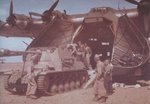cheddar cheese
Major General
On WarbirdsResourceGroup it states this about the Me-323:
"One 17.7 ton bomb was dropped in trials, though the aircraft crashed during the trials due to structural failure after the test aircraft had been straffed by Allied fighters days earlier."
Does anyone have any more information about this that would back it up?
"One 17.7 ton bomb was dropped in trials, though the aircraft crashed during the trials due to structural failure after the test aircraft had been straffed by Allied fighters days earlier."
Does anyone have any more information about this that would back it up?


